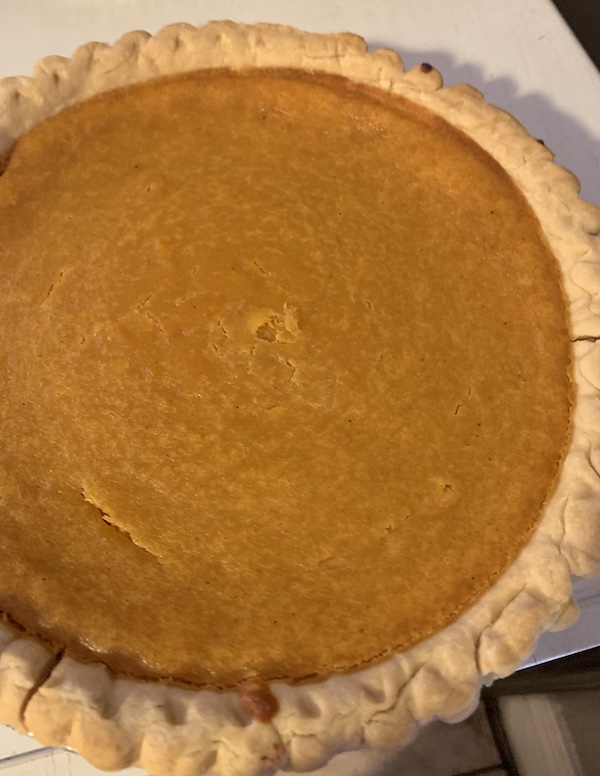
Yes, this piece is about sweet potato pie, that wonderful dessert.
What provoked me were the season and the resurrection of a newspaper article in the Washington Post from a few years ago. In addition to discussing the history of the sweet potato, the author of the article discussed the sweet potato pie as an African American tradition.
He proclaimed to the world,
“For millions of African Americans like me, Thanksgiving Day means sweet potatoes, not pumpkins, and we love sweet potatoes so much that we won’t settle for having a sole side dish of candied sweet potatoes (we call them “yams,” but that’s another story) or sweet potato casserole. No, we have to double down on this tasty tuber and serve up sweet potato pie for dessert, too. Sure, we eat this soul food classic year-round, but this is the week that the sweet potato pie really shines. It doesn’t have to be the only dessert option on the holiday table, but it has to at least be part of the lineup. Otherwise, at least in African American households, the spread is immediately suspect.”
As Walter Cronkite used to say, “That’s the way it is.”
Compared to pumpkin pies, most sweet potato pies are good.
I love sweet potato pie; however, that love is conditional. I love potato pie only when made in my hometown area of southwest Alabama. I have seldom tasted a delicious sweet potato pie not made there.
Yes, I know that it is possible for others to sometimes make sweet potato pies just as good. Once upon a time, I tasted one in Pennsylvania that was similar, no doubt baked by a transplant from southwest Alabama.
I knew the taste around my hometown because I ate around, so to speak, as a youngster. For example, I made the rounds of food tables at the annual homecomings at my church. Good food abounded, but the sweet potato pies stood out. While some were better than others, all were good.
My mother, my grandmothers, and my sister Juanita were masters of the sweet potato baking art.
Once, long ago, one of my sister’s pies netted me a new girlfriend.
Where I grew up, our sweet potatoes came in two colors—red (orange) and white. The white sweet potato is sweet like the red sweet potato and never stringy, as is sometimes the case with red sweet potatoes.
Red sweet potato pies are more popular, but many cooks make both red and white pies. These two colors enabled the teenaged me to consider them as two different desserts and argue for two slices—one of each.
Momma Vallie, my mother’s mother, specialized in white sweet potato pies. They were so creamy good they were almost soft.
Not many people know I love sweet potato pie because I seldom accept offered slices, usually finding ways to avoid eating sweet potato pie made outside of my hometown area.
When I moved to the North decades ago, I quickly learned that I was in a different pie area when friends would compare sweet potato pie to pumpkin pie, which I dislike. On the other hand, I soon discovered that in the North sweet potato pies often taste somewhat like pumpkin pies, which is a very disappointing experience.
Last year, I might have offended my sister Betty when I discussed Patti Labelle’s sweet potato pies sold in grocery stores. I indicated that those pies were surprisingly among the best I had tasted outside of our home area. Betty’s reaction suggested that she did not readily accept the idea that “store-bought” sweet potato pies were worthy of that kind of praise.
Sweet potato pies made by my relatives were special treats. And sometimes, they were powerful. Once, long ago, one of Juanita’s pies netted me a new girlfriend. After I visited home, she baked me a pie to take back North. Later I shared a slice with a young lady — and she came back for more.
‘Nuff said.
• • •• • •
Wornie Reed is Professor of Sociology and Africana Studies and Director of the Race and Social Policy Research Center at Virginia Tech University. Previously he developed and directed the Urban Child Research Center in the Maxine Goodman Levin College of Urban Affairs at Cleveland State University (1991-2001), where he was also Professor of Sociology and Urban Studies (1991-2004). He was Adjunct Professor at the Case Western Reserve University School of Medicine (2003-4). Professor Reed served a three-year term (1990-92) as President of the National Congress of Black Faculty, and he is past president of the National Association of Black Sociologists (2000-01).
This column first appeared online at What the Data Say and is shared here by permission.














